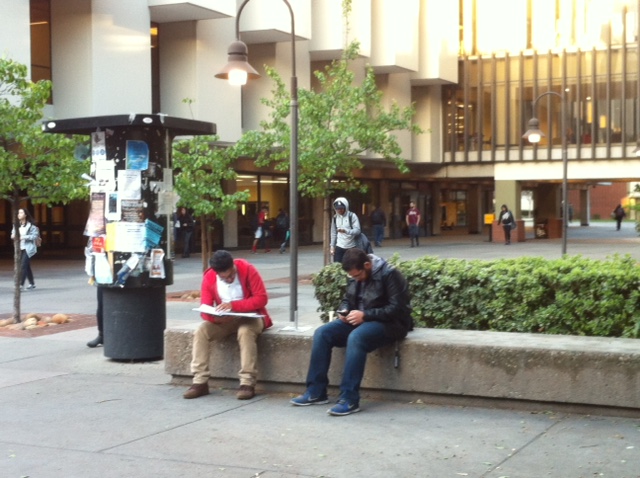
Black teachers: How to recruit them and make them stay

Lessons in higher education: What California can learn

Keeping California public university options open

Superintendents: Well-paid and walking away

The debt to degree connection

College in prison: How earning a degree can lead to a new life

At Cal State Los Angeles, a mainly commuter campus in the hills east of downtown, the winter quarter is ending – likely forever.
The 25,000-student university is joining a Cal State system and national trend to abandon the quarter term calendar, with its three speedy terms a year of 10 weeks each. In its place, it is adopting the less hectic system of two 15-week-long semesters a year.
The Los Angeles campus and its sister Cal State in Bakersfield are making the change this fall. Similar switches are expected to follow over the next four years or so at the four other Cal States remaining on quarters – East Bay, Pomona, San Bernardino and San Luis Obispo. The change is aimed at creating a unified time system across the CSU, since its other 17 campuses long have been on semester calendars.
The change is controversial, complicated and expensive – at least $40 million for all six campuses. But backers insist it will bring educational benefits, particularly to the many students who are in the first generation in their families to attend college and to the many who are placed in remedial or developmental courses at Cal State campuses. For them, educators say, the quarters move too quickly. The semester system, proponents contend, will allow students more time to master course material and to get to know professors better. Officials hope it ultimately will improve retention and graduation rates.
Melina Madrigal, a third-year social work student at Cal State Los Angeles, said she is looking forward to the conversion. With quarters, “midterms come too fast and then the finals. Everything goes too fast,” she said during a lunch on a campus patio. That pace is especially tough for the many students like her who also work 40 hours a week off campus, in her case at a McDonald’s restaurant. “Semesters would be better for us,” she said. “We would have more time to study.”
“You’ve got all the kinds of social, financial, emotional as well as intellectual challenges to adjust to in the university. Then it’s a big shock when you get into this fast-paced 10-week period.” – Rennie B. Schoepflin, Cal State Los Angeles history professor who is its director of the semester conversion effort
In addition, the change to the semester schedule will make it easier for students to transfer from community colleges, almost all of which are on semester calendars, and from one Cal State to another, officials said. Semesters align better too with many internship schedules. And the semester system reduces the hassles and expenses of three registrations, course catalogs, report cards, financial aid packages and book purchases a year.
For CSU, the quarter system “created some inefficiencies,” explained Rennie B. Schoepflin, the Cal State Los Angeles history professor who is its director of the semester conversion effort.
Most important, he said the change will help Cal State L.A. students, 82 percent of whom are first generation, many from Latino and Asian immigrant families. Many freshmen struggle with the unforgiving pace of quarters.

LARRY GORDON/EDSOURCE TODAY
Cal State L.A. campus
About 20 percent of Cal State L.A. students do not return after their first year, and just 45 percent of entrants graduate in six years, campus statistics show.
“You’ve got all the kinds of social, financial, emotional as well as intellectual challenges to adjust to in the university. Then it’s a big shock when you get into this fast-paced 10-week period,” Schoepflin said. “It takes a week to get your bearings. Second week you recognize you had better pay attention. Third week you can be a week behind. You can be lost at midterms and you get an F at that first exam. And then what?”
(Eight of the University of California’s 10 campuses are quarter holdouts. At UC, where incoming students generally have stronger high school academic records than Cal State students, faculty say quarters allow them to teach more specialized courses and that it is easier for them to take a quarter off for research than to miss an entire semester. Only Berkeley and Merced are on semesters, and no change is expected at the others, officials say.)
The semester calendar doesn’t guarantee success but provides “more time for them to catch up and get the help they need,” Schoepflin said. His campus adopted the quarter calendar in 1967, when colleges were making room for an influx of Baby Boom college students.

Credit: Larry Gordon/EdSource Today
Cal State East Bay student government leader Janeesha Jones supports the switch to semesters.
Making the change will cost about $7 million at his campus for such things as a revamped computer systems and student records, increased counseling and changes in faculty assignments, he said.
Still, the quarter system has its fans. It allows students to take a wider variety of classes – often 12 courses a year versus 10 during semesters. If a course proves to be a turkey, students get through it faster. Boosters say the schedule better prepares students for the workplace, where procrastination isn’t tolerated.
“The quarter system makes you more efficient. You can’t drag your feet on assignments,” said Cal State junior Mitchell Tran, a biology major. “For high school students who struggle, it’s a good adjustment for them. Growing up we have to adjust, and this is one of those adjustments you have to make.”
Those in the sciences and engineering tend to like quarters’ speed in getting through required courses. That is partly why many faculty and students at Cal Poly San Luis Obispo tried to rebel against the Cal State system’s pressure to switch by 2020. In a 2012 survey at that campus, one student wrote: “The semester system is an unrealistic model of the real world . … It allows time for slacking and gives students the chance to develop poor study habits.”
Besides, opponents argue, any benefits would not be worth the estimated $18 million cost at San Luis Obispo.
Interviews and documents indicate that $40 million is a rough baseline for possible system-wide costs. But Cal State System spokeswoman Toni Molle said there is no solid estimate yet, and she cautioned that expenses will include curriculum changes not tied to semesters but introduced simultaneously.
Cal State system officials say the San Luis Obispo change will happen although timing remains under discussion. Cal Poly Pomona and Cal State East Bay are set to convert in 2018, with San Bernardino and SLO later.
Certainly, SLO swims against the academic tide. Federal statistics show that only 12 percent of 2,340 U.S. four-year public and not-for-profit colleges and universities were fully on the quarter calendar in 1994; that dropped to just 6 percent by 2014. A small number of colleges use various other schedules.
The Ohio State University system, which enrolls 66,000, switched from quarters to semesters in 2012 after much debate and more than $12 million in costs. Registrar Brad A. Myers said it is not clear whether the change aided a recent 2 percent uptick in freshmen retention rates. Still, he said it appears to bolster learning since “there is a little more time to allow things to sink in.”
Academics bemoan the lack of a wide-ranging national study comparing student outcomes between the calendars. A planning report at Rochester Institute of Technology, which switched to semesters in 2013, said claims for improvement seem “sensible and intuitive” but “hypothetical” until such a comprehensive survey is done.

LARRY GORDON/EDSOURCE TODAY
Cal State East Bay campus
Conversion planning is underway at CSU East Bay, which enrolls 15,000 at its main campus above the San Francisco Bay in Hayward and two satellite facilities.
Janeesha Jones, an East Bay business major who is a student government vice president, said she has seen first-generation students like her without family experience of college life drop out as freshmen in part because of the fast schedule. In addition, being on a semester calendar will make it easier to apply for internships since spring semesters usually finish in May while East Bay’s spring quarter ends in June. “It’s going to be good to be on the same system as everyone else,” she said.

Legislation that would remove one of the last tests teachers are required to take to earn a credential in California passed the Senate Education Committee.

Part-time instructors, many who work for decades off the tenure track and at a lower pay rate, have been called “apprentices to nowhere.”

A bill to mandate use of the method will not advance in the Legislature this year in the face of teachers union opposition.

Nearly a third of the 930 districts statewide that reported data had a higher rate of chronic absenteeism in 2022-23 than the year before.
Comments (3)
Comments Policy
We welcome your comments. All comments are moderated for civility, relevance and other considerations. Click here for EdSource's Comments Policy.
Andrew 8 years ago8 years ago
"Claims for improvement seem 'sensible and intuitive' but 'hypothetical' until such a comprehensive survey is done." I think that's also a historical justification for putting butter on burns, which we now know as medically harmful. Even then, the argument that quarter systems allow more time for material to sink in is only "sensible and intuitive" if we assume that in transitioning from quarters to semesters, professors simply stretch 10 weeks of material to fit … Read More
“Claims for improvement seem ‘sensible and intuitive’ but ‘hypothetical’ until such a comprehensive survey is done.” I think that’s also a historical justification for putting butter on burns, which we now know as medically harmful. Even then, the argument that quarter systems allow more time for material to sink in is only “sensible and intuitive” if we assume that in transitioning from quarters to semesters, professors simply stretch 10 weeks of material to fit 15 weeks, and programs cut 1/3 of required units to make it all fit into 4 years. If instead a professor uses those extra 5 weeks to put in 50% more material per class, students are still in the same boat.
The real reason for pursuing a switch like this is politics: the state feels retention rates are too low and conditions future CSU support on getting them up. Current CSU support is too low to fully pursue peer-review proven techniques for upping retention, like offering enough sections of required courses to meet student demand, increasing the percentage of courses taught by full-time and tenure track faculty, reducing class sizes, modernizing learning environments, providing aid and space for more students to live on campus for more years, offering more summer “head-start” programs to help at-risk students acclimate to the college environment, etc. So, to appease the politicos in Sacramento, CSU admin is throwing a one-time $40 Million at a “solution” that sounds like it might possibly have something to do with retention to get the government off their backs. At the same time, they push a mandate to CSU faculty to completely redesign their curriculum to fit into quarters and offer no added compensation or time to do a good job of it, and if some departments and faculty happen to just stretch the same material they teach in a 10-week quarter to fit into a 15-week semester, and if that happens to improve retention at the expense of cutting material covered by 33%, no one is going to complain.
Cathy Straus 8 years ago8 years ago
Quarters benefit students who want more classes in their major, allowing them to learn more. There are plenty of semester schools, let those who are capable have options for quarters. Perhaps it is the quarter system that makes Cal Poly the jewel of the CSU system. Cal Poly, if a UC would be one of the highest rated schools. Saying quarters makes it difficult for transfers or internships doesn't pan out at Cal Poly where … Read More
Quarters benefit students who want more classes in their major, allowing them to learn more. There are plenty of semester schools, let those who are capable have options for quarters. Perhaps it is the quarter system that makes Cal Poly the jewel of the CSU system. Cal Poly, if a UC would be one of the highest rated schools. Saying quarters makes it difficult for transfers or internships doesn’t pan out at Cal Poly where there are many more transfer applicants than spots for them, and Cal Poly has an extremely high rate for internships. Semesters are boring, GEs take a huge percent of the total classes, and spending 15 weeks to learn what can be taught in 10 is too slow for top students. I find it interesting that many top universities on semesters have cut down the number of weeks. For example Yale has only 128 school days a year while Cal Poly has 147, not sure how many semester programs actually teach for 15 weeks a semester, many I know of only have 14 or fewer weeks of instruction with the 15th week being finals. I personally wonder if this push to semesters may be the reason employers are complaining that graduates are not properly prepared to start jobs. I know Cal Poly has a reputation for graduating students who can start work immediately. Maybe it would be better for more schools to change to the quarter system.
Replies
ThomasFromTN 5 years ago5 years ago
Jewel of the CSU system? Seems to me you're laying the plaudits on a bit thick for what I presume was intended to be an objective assessment of not Cal Poly, but the quarter versus the semester system. One glaring distinction between quarter vs semester is that quarter promotes breadth while semester promotes depth. I attended both quarter and semester system schools, and my verdict pretty much comes down to this: The benefits of … Read More
Jewel of the CSU system? Seems to me you’re laying the plaudits on a bit thick for what I presume was intended to be an objective assessment of not Cal Poly, but the quarter versus the semester system.
One glaring distinction between quarter vs semester is that quarter promotes breadth while semester promotes depth. I attended both quarter and semester system schools, and my verdict pretty much comes down to this: The benefits of either pretty much come down to the student, not the system.
While CalPoly is a STEM-centered school, not every individual desires to pursue a STEM-based professional orientation – which is not necessarily the same as saying that not every student is “cut out” for a hard science oriented curriculum/profession. I attended a top school as an engineering major (um…rated, nationally, just a mite above CalPoly), was the only freshman in a math class full of juniors and seniors from the engineering department (after acing the placement testing), did just fine in math, physics, chemistry – but, man, was it boring. (I switched to Economics. Glad I did.) All due respect, I am inclined to think that techies unfairly sniff at the “soft skill” curriculum, when perhaps a few of them might benefit from availing themselves of opportunities to take a few “electives” vs major courses for the broader academic experience. “Just because a thing can be invented doesn’t mean it should be” – that sort of thing.
Employers complain that a lot of graduates are not prepared for life as a working professional; one of the more persistent complaints employers articulate is that students, some for all their “top” status, demonstrate egregious preparedness insofar as having cultivated effective communication skills. In the quarter system, there is typically not the opportunity to really probe topics as fully – and some warrant serious and comprehensive examination. Point being – there are a lot of reasons employers complain about graduates and their preparedness for the workplace.
The real point being – I recognize you are advocating pretty transparently for the quarter versus semester system as the “superior” academic experience. You certainly are entitled to your opinion. But it is your opinion, based upon adopting a context fairly narrowed to “fit” your premises. CalPoly is not everyone’s first choice. Neither is the quarter system. Different – not better.